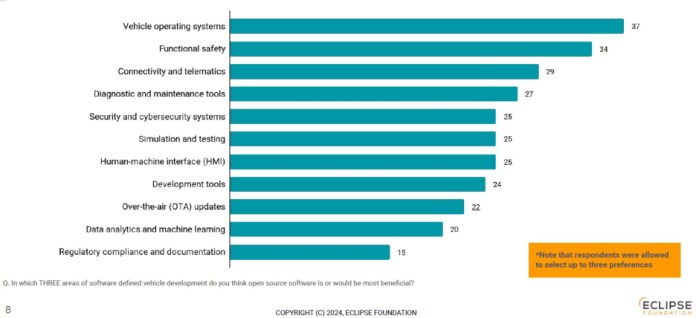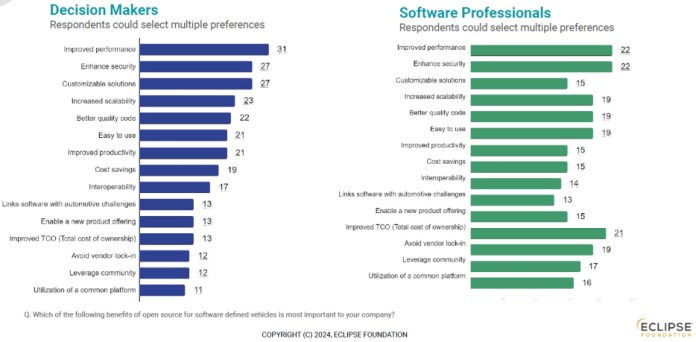The Eclipse Foundation has released a research report on the use of open-source software (OSS) in software-defined vehicles (SDVs) and its impact on automotive technology development. The report, “Driving Innovation & Building Safer Cars with Open Source Software,” surveyed more than 300 global decision-makers and software professionals to gain insights into how the automotive industry is adopting OSS for vehicle design and production.
OSS, once relegated to applications such as vehicle infotainment systems, is rapidly gaining traction due to widespread improvements over proprietary software and the move toward a centralized computing architecture by the industry. Key findings show that OSS is playing a critical role in driving flexibility, innovation and efficiency in the industry.
Commissioned by the Eclipse Foundation’s Software Defined Vehicle Working Group, the survey findings support the increased use of OSS and key trends in automotive technology:
- Companies expect a 10% increase in innovation by leveraging open-source technologies and collaboration, with 20% of those surveyed expecting a 20% to 30% increase.
- Ninety-five percent of professionals expect OSS to increase flexibility and scalability in SDVs to improve business opportunity capitalization, reduce costs, shorten time to market and gain a competitive edge.
- The top reasons why developers prioritize OSS include ease of use (29%), enhanced security (25%), customizable solutions (22%) and the use of a common platform (21%).
- For decision-makers, the top benefits of OSS include improved performance (31%), enhanced security (27%) and customizable solutions (27%).
What the Eclipse survey tells us
Geographically, survey participants were equally represented in North America (32%), Europe (32%) and Asia-Pacific (32%). This is the industry’s first deep dive into the role and adoption of OSS in SDVs and its impact thus far, according to Eclipse.
Insights from the survey show that automotive decision-makers and software professionals are unanimous in recognizing the value of OSS use in SDVs. Nearly all survey respondents, software professionals (100%) and decision-makers (99%) find OSS very or somewhat valuable. While software pros focus on creating safer and more intuitive vehicles and interfaces, improving accessibility for people with disabilities and providing more unique user experiences, the focus of decision-makers is on innovation, differentiation, efficiency and sustainability.

Developers are enthusiastic about working on innovative, cutting-edge technology, with 97% expressing high interest in SDVs. (Source: Eclipse Foundation)
Why is OSS stepping into a more central role? According to RedHat, traditional proprietary software development is managed by an organization and a single team within it, and software development, modification and testing are performed by the organization that owns the code. For automakers, challenges increase when trying to integrate proprietary software with their open-source software.

OSS is an asset when abstracting non-differentiating components, with the most significant benefits found in vehicle operating systems and functional safety. (Source: Eclipse Foundation)
OSS, with cost savings, speed and ease of design, and innovation capabilities, is streamlining the development process while eliminating duplication of efforts. The use of open technologies not only enables innovation but also provides more robust and reliable technologies. OSS also curtails the risks of overdependence on single vendors to enable a more vendor-neutral approach, improves cost efficiencies, and promotes and accelerates standardization. As the SDV industry rapidly evolves, OSS assists in creating a regulatory environment that fosters technology advancement, cuts costs, enhances vehicle safety and quality, and delivers a more competitive industry.

The practical benefits of open-source software in SDV design include enhanced performance, increased security and greater flexibility. (Source: Eclipse Foundation)
There are still challenges
As the industry transitions from a hardware-centric to a software-centric model, several challenges exist. Data privacy, regulation, reliability, safety, safety standard compliance, integration complexity, cybersecurity and interoperability are still roadblocks, according to Luxoft.
Integration of a variety of components from different manufacturers that are interoperable and communicate is still a significant challenge. There is a lack of standardized protocols and interfaces complicating interoperability, as well as a variety of communication protocols that make effective communication a complex task, often necessitating protocol converters and gateways to bridge gaps. There are also many regulatory hurdles and safety standards globally and constant autonomous-vehicle legislation.
Solving technology challenges calls for greater OSS collaboration. It is just too big for individual companies to take on. The automotive industry is shifting from a hardware-centric to a software-focus, but there is still resistance to throwing the doors of collaboration wide open. Although it will take time, it will happen, given the necessity for an industry-standard approach toward SDVs.

Open-source software boosts productivity, enabling developers and decision-makers to focus on innovation and differentiating features. (Source: Eclipse Foundation)
Despite the challenges, the productivity boost seen thus far and the resulting time-to-market acceleration represent sufficient industry buy-in by Tier 1 suppliers and OEMs to offset the time it will take to deal with the remaining challenges.
More data coming
The Eclipse SDV Working Group’s first survey will soon be followed by two more reports: “The Business Value of Open-Source Software in the Automotive Industry” and “Challenges Facing Open-Source Software in the Automotive Ecosystem.” Visit the Eclipse SDV Working Group at the Open Community for Automotive conference, part of the Open Community Experience (OCX), Oct. 22–24, in Mainz, Germany.
Advertisement





